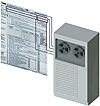Your money
- Online banking
- ATM of tomorrow
- ATM graphic
- Tax filing graphic
Investing online
Web auctions
Privacy issue
User tracking
Cybershrink
Profile: Sherry Turkle
Gadgets
Digital devices
Communication
- Wireless satellite phones
- Calling online
- Smart pagers
Do-it-yourself
Photo editing
Education
Teachers keep in touch
Listings
'Net Marketplace Online Directory
|
 |  |  |  |
 |
Taxes in cyberspace
The time-honored practice of wading through IRS forms and documentation - or paying someone else to do it for you- is still Americans' preferred method of handling their income taxes, accounting for four out of five returns. But since its 1986 debut, electronic tax filing has grown rapidly, and IRS officials expect the number of "e-filers" to increase by 5 million this year alone. Expanding electronic services is part of the agency's long-term goal to reduce paperwork as much as possible.
|
Computer processing will help ease the burden of handing some 100 million paper tax returns this year, but processing the paper is still a labor-intensive task. Here's where your Form 1040 goes:
|
LAST YEAR'S RETURNS
- 100 million returns
- 4-6 weeks to process
- 40-day average turnaround
|
|
( 1 ) Returns are delivered to regional processing centers. Envelopes are opened and enclosed checks are totaled.
( 2 ) Returns are sorted by type: single, married filing jointly, etc. Returns are compared to enclosed checks.
|

|
|
( 3 )
Returns are checked for errors. Computer operators input data from each return. Computers check for mistakes. One in five has some mistake, usually a wrong Social Security number.
( 4 )
Computer files are transferred electronically to the IRS computing center in Martinsburg, W. Va. for central storage.
|

|
|
( 5 ) Refund information is sent to the Philadelphia mint, where checks are issued. Regional centers send out notices if tax payments are due.
|

|
|
The IRS is working to reduce paperwork by allowing taxpayers to file by computer or touch tone telephone. It is also testing electronic alternatives to the signatures required by law. Here's how "e-filing" works:
|
LAST YEAR'S RETURNS
- 24.5 million returns
- 3 weeks to process
- 15-day average turnaround
|
|
( 1 )
Your return is done using tax software. Data is converted to an IRS-specified format and sent via the Internet. You sign a Form 8453 and send it by mail to complete your return.
( 2 )
IRS computers check your
Social Security number,
and verify data formats. If there is a
mistake, an electronic message is sent pinpointing needed corrections. If there are no mistakes, the IRS acknowledges receipt within 48 hours of filing.
|

|
|
( 3 )
Computer processing in Andover, Mass. checks math and searches for schedules and forms cited in your return. Your return is compared to analyses of similar taxpayersUs returns to identify a possible need for later audit.
( 4 )
Computer files are transferred electronically to the IRS computing center in Martinsburg, W. Va. for central storage.
|

|
|
( 5 )
Instead of getting a check, the Treasury can transfer your refund straight into your bank account. Unpaid taxes can be paid by check, credit card, or by authorizing an electronic transfer from your bank account.
|

|
SOURCES: IRS, Intuit
GLOBE STAFF GRAPHIC / SEAN McNAUGHTON
|
|


